大学中级财务会计学课后习题复习资料
- 格式:docx
- 大小:28.45 KB
- 文档页数:7
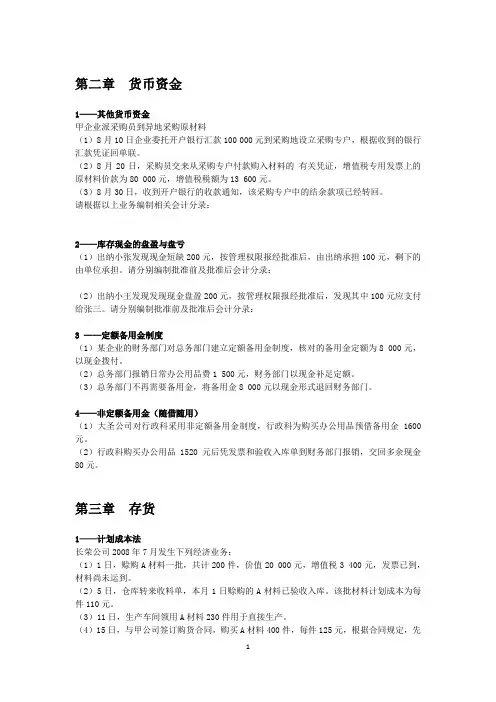
第二章货币资金1——其他货币资金甲企业派采购员到异地采购原材料(1)8月10日企业委托开户银行汇款100 000元到采购地设立采购专户,根据收到的银行汇款凭证回单联。
(2)8月20日,采购员交来从采购专户付款购入材料的有关凭证,增值税专用发票上的原材料价款为80 000元,增值税税额为13 600元。
(3)8月30日,收到开户银行的收款通知,该采购专户中的结余款项已经转回。
请根据以上业务编制相关会计分录:2——库存现金的盘盈与盘亏(1)出纳小张发现现金短缺200元,按管理权限报经批准后,由出纳承担100元,剩下的由单位承担。
请分别编制批准前及批准后会计分录:(2)出纳小王发现发现现金盘盈200元,按管理权限报经批准后,发现其中100元应支付给张三。
请分别编制批准前及批准后会计分录:3 ——定额备用金制度(1)某企业的财务部门对总务部门建立定额备用金制度,核对的备用金定额为8 000元,以现金拨付。
(2)总务部门报销日常办公用品费1 500元,财务部门以现金补足定额。
(3)总务部门不再需要备用金,将备用金8 000元以现金形式退回财务部门。
4——非定额备用金(随借随用)(1)大圣公司对行政科采用非定额备用金制度,行政科为购买办公用品预借备用金1600元。
(2)行政科购买办公用品1520元后凭发票和验收入库单到财务部门报销,交回多余现金80元。
第三章存货1——计划成本法长荣公司2008年7月发生下列经济业务:(1)1日,赊购A材料一批,共计200件,价值20 000元,增值税3 400元,发票已到,材料尚未运到。
(2)5日,仓库转来收料单,本月1日赊购的A材料已验收入库。
该批材料计划成本为每件110元。
(3)11日,生产车间领用A材料230件用于直接生产。
(4)15日,与甲公司签订购货合同,购买A材料400件,每件125元,根据合同规定,先预付货款50 000元的40%,其余货款在材料验收入库后支付。

第一章 绪论一、概念题:1、财务会计:以传统会计为主要内容,以提供企业外部利益主体所需的经济信息为主要任务,使用的重要会计手段是复试记账、编制与审核凭证、登记账簿,编报财务会计报告等。
在财务会计中,会计凭证上反映的经济业务是已经发生的会计事项,记账凭证上反映的应该是根据公认会计原则确认和计量的结果,财务会计报表反映的是账实相符的、外部利益主体关心的、以财务信息为主的经济信息,并且这些经济信息必须以规定的格式、相同口径的经济指标反映。
2、管理会计:是适应现代企业管理需要,突破传统会计而发展起来的,以财务会计资料为基本依托、相对独立的会计学科。
其服务对象是企业内部各级管理人员,不需要固定的程序,既不受任何统一的会计制度等法规的约束,也不受固定的程序和会计惯例的制约。
规范与控制是管理会计的两大内容。
3、确认:是指通过一定的标准,辨认应输入会计信息系统的经济数据,确定这些数据应加以记录的会计对象的要素,进而缺点已记录和加工的信息是否应全部列入财务会计报表和如何列入财务会计报表的过程。
4、计量:是指在企业会计核算中对会计对象的内在数量关系加以衡量、计算和确定,使其转化为能用货币表现的财务信息和其他有关的经济信息,以便集中和综合反映企业经营成果、财务状况及其变动情况。
计量的主要尺度是货币,结果主要是财务信息。
5、会计假设:是关于会计核算中的程序与方法适用的基本条件的约定,主要包括会计主体、持续经营、会计分期和货币计量。
6、会计目标:财务会计工作应达到的境地。
我国财务会计的基本目标是向财务会计报告的使用者提供与企业财务状况、经营成果和现金流量等有关的会计信息,反映企业管理层受托责任履行情况,有助于财务会计报告使用者作出经济决策。
二、简答题:1、如何理解会计的目标?答:(1)财务会计的目标是指财务会计工作应达到的境地。
在多数情况下,人们基本上把财务会计的目标与财务会计报表的目标等同起来。
(2)我国财务会计的基本目标是向财务会计报告的使用者提供与企业财务状况、经营成果和现金流量等有关的会计信息,反映企业管理层受托责任履行情况,有助于财务会计报告使用者作出经济决策。

中级财务会计复习资料Documents from the network, I collected, finishing, and if there are omissions, errors, but also please correct me!Intermediate financial accounting review materialsFirst, individual choice:1.Which of the following does not fall into the general principle of accounting in our country?A,substance is more important than form B, continuous operation, C, objectivity, D, importance2,in accordance with the relevant provisions of the cash management system, the following expenditures should not be paidin cash;()A,pay worker salary 35000 yuan B, pay commodity price 5000 yuanC,pay medical expenses 1000 yuan D, buy office supplies 500 yuanAt the end of 3, the enterprise checkout, no account balance isA, annual profit B, prepaid expenses, C, profit distribution,D,production costs4, use enterprise according to the provisions of the statutory common welfare fund isA, B, C to make up for the loss of capital, collective welfarefacilities in D, the distribution of dividends5 the time limit for payment of commercial drafts shall be agreed upon by both parties, but shall not exceed () monthsA, 3 B, 6 C, 9 D, 126,the enterprises that have prepared the bad debts have been confirmed and cancelled as the bad debts, and the receivable shall be paid back laterA,debit the bank account, and credited the management expense accountB,debit the accounts receivable, and credited the bad debt reserve accountC,debit the bank account, and credited the accounts receivableD,B, and C7,the rapid depreciation method of fixed assets will enable enterprises during the acceleration periodA, profits decreased by B, profits increasedC, profit is not affected, D, A or B8,the cause of the receivable account is ()A, B, C. & D. are sold on credit9,the following items do not belong to "payable welfare benefits”, accounting content is ()A, from the cost of welfare benefits extracted B, workers living difficulties subsidiesC, welfare benefits extracted from the net profit, D, pay the wages of staff bathroom managers10,the enterprise short-term investment valuation by lower cost and market price method, in June 30, 2000 ''short-term investment depreciation, prepare a A stock" account credit balance 600 yuanIn December 31, 2000, the cost of A shares was 6500 yuan, the market price was 5000 yuan; in June 2001, 30 ID, the cost of A shares did not change, the market price was 5500 yuanAccording to the above information, June 2001, 30, the enterprise should be A shares ()A,plan to invest in short-term investments, depreciation of 1000 yuanB,plan to invest in short-term investments, depreciation of 500 yuanC,plan to invest in short-term investments, depreciation of1500 yuanD,write down short-term investment depreciation 500 yuan11,the total amount of investment contributed by the enterpriseto the intangible assets of investors shall not exceed that of the enterprise,s registered capitalA, 30%B, 25%C, 20%D, 10%12, D companies to accept A company put into a device, theoriginal price of 50000 yuan, net book value of 30000 yuan, the assessment price of 35000 yuanWhen the D company accepts the equipment investment, the amount of the "paid in capital" account is ()A, 30000 yuan, B, 35000 yuanC, 50000 yuan, D, 20000 yuan13,during the period when prices continue to rise, the minimum method of inventory valuation for the enterprise's current profits is:()A, LIFO, B, first in first outC, weighted average method, D and individual valuation method14,according to the "income" standards, the following business should be recognized as the company,s main business income ofthe yearA, December 25th sales of a batch of products, the price of 1million yuanOn the same day, receipt of the same amount from the purchasing unit and a commercial bill due by 3 monthsA batch of excess materials sold forB and May 20th, received at $200 thousand and deposited in the bankC,September 30th sales of a batch of products, the price of 150 thousand yuanHowever, the financial condition of the purchasing unit has deteriorated considerably, and the possibility of recovery is very smallD,December 30th issue a batch of goods, the price of 500 thousand yuan, commissioned by the C Company consignment15 the following items of cash outflows belonging to investment activities are ()A, cash received from maturity of bonds, B, and cash paid for bond repaymentC, the cash paid for the purchase of bonds, D, the cash received from the issue of bonds16.Requirements for the preparation of accounting statements includeA, digital reality, content integrity, B, accurate and timely submissionC, easy to understand, D, A and B17,the following shall not be included in the management fee is 0A, business entertainment, B, retiree salariesC, enterprise organization expenses allowance for bad debts, confirm D amortization18 the following items which are not in stock are ()A, engineering materials, B, issued inventory for exhibitionC, consignment commodity D, installment merchandise19,an enterprise accounts receivable balance percentage method of accounting for bad debts, 2002 annual accounts receivable 56000 yuan, bad debt extraction rate of 5%, enterprise extract bad debt preparation before bad debt preparation account has credit balance 1000 yuanThe amount of bad debts payable by the enterprise in 2002 shall be RMB yuan (RMB)A, 3800 B, 1800 C, 2800 D, 480020, a commodity transaction price of 1000 yuan, the conditionsfor 〃2/10, 1/20, N/30〃,and if the payment in tenth days, theamount required to pay () yuanA,980 B, 990 C, 1000 D, 105021,material procurement reasonable loss on the way should be includedA, management fee B, compensation by transportation departmentC, material procurement costs, D, non operating expenses22,Determine the quantity of ending inventory by inventory and then calculate the quantity of inventory issued in this period. This method is called ()A, perpetual inventory system, B, physical inventory systemC, accrual basis D, cash basis system23,the enterprise purchases the stock investment, the actual payment price included in the declaration has not yet received cash dividends should be credited to () accountA, short-term investment, B, long-term equity investmentC, investment income D, dividends receivable24.The liquidation expenses for the sale of fixed assets shall be included in () accountsA, management fees, B, liquidation of fixed assetsC, non operating expenses, D and other business expenses25,when the enterprise finance leases the fixed assets, when the delivery uses, should ()A, for future reference registration, B, included in fixed assetsC, included in other long-term assets D, included in long-term prepaid expenses26,The intangible assets that cannot be priced separately in the following assets are ()A, patent, B, trademark rightC, land use rights, D, goodwill27,when one party has the voting capital of the other party, it may be deemed to have a significant impact on the other partyA, 50% B, more than 10% to 60% C, more than 20% to 50% D, lessthan 20%28,the following types of payment for collection withacceptance settlement is ()A, product processing fee, B, and goods sold on commissionC, the amount of money to be sold, D, and money arising from the trade of goods29,in the use of inventory of "cost and net realizable value of the lower law”, when the net realizable value of the inventory is lower than the cost, with () method of ending inventory cost minimumA, individual comparison method, B and classification comparison methodC, total comparison, D, and three methods are possible30,The following items are within the scope of packingA, disposable packaging, B, packaging for storageC, the packaging for the manufacture of goods for sale, D, and packages for rental units31,in the amount of money under the accounting methodThe "inventory" account reflects the goodsA B, the purchase price and actual priceC, price D, planned price32,during the period of rising pricesAdopt () valuationWill make the minimum profit of the yearA, first in first out, B, individual pricingC, last in first out method, D and weighted average method33,the long-term interest income of a long-term bond investment purchased by an enterprise is equal to ()A, accruals + premium amortization, B, accruals, premium amortizationC, accruals + discount amortization D, accruals amortization34,in the long-term equity investment under the equity lawAmong the following items of the investment enterprise, the book value of the long-term equity investment of the investment enterprise and the ''investment income" are reducedA, loss of B, foreign donated assetsC, asset assessment, impairment of D, dividend distribution to investors35,the following does not constitute the cost of short-term investment is ()A the cash dividend declared but not yet included in the purchase price of the sharesB,the price paid for the purchase of sharesC,the fee paid for the purchase of sharesD fee for the purchase of bonds36,for one-time use of inventory, packaging items should be accounted for in () accountsA, materials in transit, B, material purchasingC, raw materials, D, packagingIn 37, during the long term debt liquidation expenses, shall be credited toA, the value of the liquidation assets, B, management feesC, liquidation profit and loss, D, financial expenses38, this year found that non significant accounting errors belong to the previous year, should be adjustedA, the current accounting statements related items B, error year accounting statements related projectsC, prior to the annual financial statements related to the project D, and finds the initial retained earnings for the erroryearIn 39, the new enterprise system, specialized in the sales organization of office expenses, shall be recorded in the accounts isA, operating expenses, B, sales expenses, C, management fees, D, financial expenses40, the following income, will not increase the profit of enterprises isA, sales of self-made semi-finished products, B, sales of fixed assets incomeC,providing labor income D, interest income of bank depositsTwo, multiple choiceThe borrowing costs 1, special borrowing hasA, auxiliary expenses incurred for special borrowing, B, interest on special loansExchange differences in C, foreign currency specific borrowings, D, discounts or premiums amortization2,the following are long-term liabilities areA, payable wages, B, long term payables, C, long-term loans,D,accrued expenses3,the following not through the "bank deposits'' account, thereare ()A, bank draft, deposit B, credit card depositC, deposits, investment funds, D, and other deposits4,in accordance with the provisions of enterprise accounting standards,The amortization method used in the long-term bond investment discount can be as followsA, first in first out method, B and straight line methodC, LIFO, D, and the real interest rate method5,the following fixed assets in the depreciation of (A, seasonal machines, equipment, B, big repair, inactive machinery and equipmentC, unused machinery, equipment, D, unnecessary machinery and equipment6,The following expenses may be accounted for as long-term deferred expensesA, start-up costs, B, and rental improvements in fixed assetsC, fixed assets, large repair costs, D, stock issuance costs7,the following intangible assets may be separately priced for foreign investment;()A, patent, B, trademark rightC, goodwill, D, land use rightsE.non patented technology8 in the following items, those who have non operating income shall have ()A, fines, revenues, B, rental packages revenueC, the net proceeds of the transfer of ownership of intangible assets, D, insurance compensation incomeE interest income on deposits9. The following businesses do not generate cash flowsA, write off the bad debts of B, and recover the bad debts that have been written off in the previous yearC. to D, fixed assets inventory lossE share dividend10. The following fixed assets shall not be depreciated thismonthA, seasonal discontinued equipment, B, purchased and put into use this monthC, the machines sold this month, D, unused housesE operates a rental machineThree. NOUN explanation:1,reserve fund2 contingent liabilities3,gross profit margin act4 notes receivable discounted5,short term investment depreciation provision:6,permanent difference:7,after the date of the balance sheet items:8,debt restructuring:Four, Jane answer:1,why is it not difficult for enterprises to calculate the income tax directly as the basis for tax payment?2,the difference between expected liabilities and contingent liabilitiesFive. Business calculation questions1.Prepare accounting entries for the following economictransactions of E company:(1)sell a batch of products, the VAT invoice shows the price of 50000 yuan, value-added tax 8500 yuan, the cash discount condition is 2 / 10, N / 30In the 10 day discount period, all payments are received by the bank (the total price method)(2) a group of shares sold as short-term investments received $45000 and paid $200 in related costs; the carrying cost of the shares was $30000(3)4000 yuan of bad debt losses recognized in the current period (with allowance for)(4) a bank acceptance bill with a face value of 100000 yuanwithout interest is applied to the bank for discounting, and the bank discount is paid at 3000 yuan2, A (general taxpayer) purchased a need to install the equipment, pays the price of 10000 yuan, tax 1700 yuan, transportation costs 500 yuan; the installation of equipment, leading enterprises with raw materials for producing a book value of 1000 yuan, the priceof 1200 yuan, the purchase of the batch of raw materials to pay 170 VAT please install the yuan; pay workers wages 1500 yuanThe above amounts have been paid by bankRequirements: (1) calculate the original value of the fixed asset;(2) an accounting entry for the purchase, installation anddelivery of the above fixed assets;3,B the company,s 2001 annual accounting profit of 500000 yuan, accounting for the year in the balance of payments including enterprise illegal business fined 5000 yuan, 20000 yuan oftreasury bond interest income, cost overruns in the hospitality business 30000 yuan, fixed assets depreciation costs 50000 yuan (tax law depreciation amounted to 35000 yuan)The enterprise income tax rate is 33%Requirements: (1) calculate the taxable income of the enterprise and the income tax expense payable under the tax payable method;(2)the accounting entries of income tax should be prepared by the payable tax payable method;(3)calculate the legal surplus reserve and public welfare fund of 10% of the after tax profits, and draw up the accounting entries(Note: the account of profit distribution shall be itemized4,the enterprise holds a face value of 100000 yuan, with a coupon interest rate of 10%, with commercial acceptance of the bill to the bank for discounting, the commercial draft for a period of 6 months, the enterprise has been held for 4 months, the bank discount rate of 12%Calculate and prepare entries for bills discounting(assuming no interest before discounting) (14 cents)1.maturity value 二2.discount interest =3.actual amount posted =4.Journal of discount accounting:5. a company purchased B in January 1, 2003, the issue of three year bonds 600000 yuanPurchase price of 585000 yuan, coupon rate of 9%, maturity of principal and interest paymentsThe bonds are ready to hold until maturity, and the company uses a straight-line method to amortize the bond premium (subject to the transaction costs of bonds): (12 points) 1) prepare the accounting entries for bonds purchased; (3 points)2,the annual end of the annual interest and amortization discount premium accounting entries (6 points);Amortisation per year 二Accrued interest =Investment income =Entries:3.Prepare the accounting entries for the principal and interest due(3 points)6 an enterprise in May 2003 1 daily bank purchased a need toinstall the equipment, indicated on the VAT invoices of the equipment purchase price of 20000 yuan, value-added tax is 3400 yuan, pay 1200 yuan; May 5th pay installation costs 3000 yuan, pay by bank deposits, the completion of deliveryThe equipment in June 30, 2003 using double declining balance method of depreciation, is expected to use 5 years, the estimated value of 400 yuanThe following accounting procedures are required:1.2003 years in May 1st (3 points)2.2003 years in May 5th (3 points)3.2003years in June 30th (6 points)Reference answerFirst, individual choice1, B 2, B 3, A 4, C 5, B 6, D 7, A 8, B 9, C 10, D 11, C 12, B 13, A 14, A 15, C 16, D 17, C 18, A 19, C 20, A, C22, 21 B 23, D 24, B 25, B 26, D27 28, C, D29, A 30, D 31, C 32, C 33, B 34, A 35, A 36, C37, C 38, A 39, A 40, BTwo, multiple choice1,ABCD 2, BC 3, ABCD 4, BD 5, AB 6, ABCD 7, ABDE 8, AC 9, BE, ACDE 10, andThree. Noun explanation1, the reserve fund: refers to the accounting department of the enterprise in advance to subordinate units or internal departments for reimbursement of spare cash daily incidental expenses, also known as the business turnover of gold 2 contingent liabilities: liabilities that an enterprise mayincur for an uncertain future3,the gross profit method: according to the enterprise actual sales for the period and the previous period or plan the gross sales gross margin calculations, calculated according to the method of inventory cost and issued at the end of inventory cost4,notes receivable discount: refers to the enterprise will not maturity of the notes transferred to the bank, by the bank according to the maturity value of the bill after deducting the discount interest calculated according to the provisions of the balance paid to the enterprise financing behavior5,short term investment depreciation provision: the difference between the lower end of the short-term investment period and the lower market cost when the short-term value of the investment is determined at the lower end of the cost and market approach6,permanent difference: refers to the accounting before tax profits and taxable income due to inconsistent calculation of the difference7,the date of the balance sheet matters: refers to matters from the balance sheet date to the financial accounting report approved between reported on the need for adjustment or explanation8,debt restructuring: refers to the creditor in accordance with the agreement reached with the debtor or the court,s decision to agree to modify the debtor,s debt conditionsFour, Jane answer1,why is it not difficult for enterprises to calculate the incometax directly as the basis for tax payment?Accounting profits are calculated in accordance with accounting standards and accounting systemsBecause the purpose of accounting standards and tax law is different, the time and scope of assets, liabilities, income and expenses are also different, which leads to the difference between pre tax accounting profits and taxable incomeThe calculation of income tax must be based on the tax law, so it can not be directly based on the accounting profit. It should be adjusted to the amount of taxable income, and the income tax is calculated accordingly2,the difference between expected liabilities and contingent liabilitiesExpected liabilities or contingent liabilities are contingent or contingent, but there is a difference between themThe main reason is that contingent liabilities are a potential obligation, and it is a present obligation to predict liabilitiesIf both belong to the reality as obligations or liabilities of the present obligation, or not is likely to result in an outflow of economic benefits from the enterprise, or the amount cannot be measured reliably; and as expected liabilities present obligation, is likely to result in an outflow of economic benefits from the enterprise, at the same time, the amount can be measured reliablyFive. Business calculation questions1.solutions:(1)when selling goods:Accounts receivable 58500Credit: main business income 50000A tax payable payable VAT (output tax) 8500 Collection within 10 days:Bank account 57330Financial expenses 1170Credit: accounts receivable 58500(2)bank deposits 44800Short term investment 30000Investment income 14800(3)borrow: bad debt preparation 4000 Credit: accounts receivable 4000(4)bank deposits 97000Financial expenses 3000Loans: notes receivable 1000002.solutions:The original value of the fixed asset 二10000+1700+500+1000+170+1500=14870 yuanPurchased pending installation:Borrow: in construction project 12200Bank deposit 12200When installing and using raw materials for production in this enterprise:Borrow: in construction project 1170Credit: raw materials 1000Taxes should be paid, VAT should be paid (input tax is turned out) 170Pay the installer,s wages:Borrow: in construction project 1500Bank deposit 1500When the installation is ready for delivery:Borrow: fixed assets 14870Credit: Construction under construction 148703 solutions:(1)taxable income = 500000+5000-20000+30000+50000-35000 二535000 yuanIncome tax payable 二535000 x 33%=176550 yuan(2)borrow: income tax 176550Credit: should pay tax, should pay income tax 176550 (3)after tax profit = 500000-176550=323450 yuanStatutory surplus = 323450 * 10Statutory public welfare fund = 323450 * 10%=32345 yuanProfit allocation - Extraction of statutory surplus reserve 32345 -Extraction of statutory public welfare fund 32345Surplus reserve 646904,1. The maturity value is =100000+100000 * 10% * 6/12=105000 (yuan)2 discount interest =105000 * 12% * 2/12=2100 (yuan)3,the actual amount of =105000-2100=102900 (yuan)4,bills discounting accounting entries:Lend a bank account 102900Notes receivable 100000Financial expenses 29005,1.Prepare an accounting entry for bonds purchased;Long term debt investment - face value 600000Loan long-term debt investment - discount 15000Bank deposits 5850002.Prepare the annual accounting journal for interest bearing and amortization premiums:Annual amortization amount =15000/3=5000 (yuan)Accrued interest =600000 * 9%=54000 (yuan)Return on investment =54000+5000=59000 (yuan)By long-term equity investments - accrued interest of 54000Long term equity investment 一discount 5000Loan investment income 590003.Prepare the accounting entries for the principal and interest dueLend a bank account 762000Long term equity investments 一face value 600000Long term equity investments - accrued interest of 1620006,1.2003years, June 1stBorrow in construction project 24600Lend a bank account 246002.2003years, June 5thBorrow fixed assets 27600Loan in construction project 24600Lend a bank account 30003.2003years, July 31stMonthly depreciation = 27600 * 2/ (5 * 12) =920 yuan By management fee (manufacturing expense) 920 Accumulated depreciation of 920。
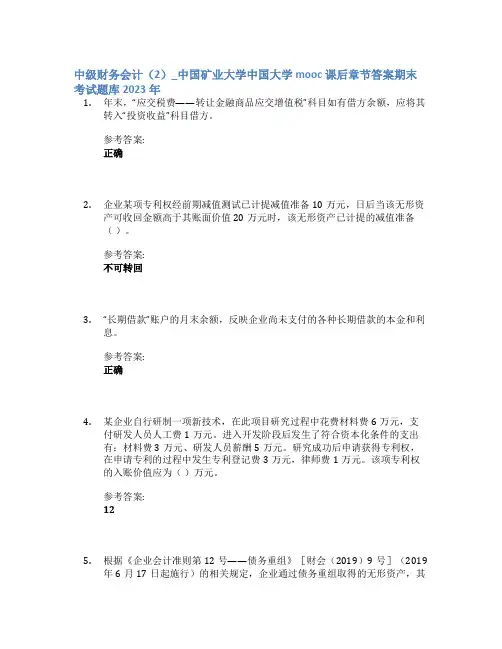
中级财务会计(2)_中国矿业大学中国大学mooc课后章节答案期末考试题库2023年1.年末,“应交税费——转让金融商品应交增值税”科目如有借方余额,应将其转入“投资收益”科目借方。
参考答案:正确2.企业某项专利权经前期减值测试已计提减值准备10万元,日后当该无形资产可收回金额高于其账面价值20万元时,该无形资产已计提的减值准备()。
参考答案:不可转回3.“长期借款”账户的月末余额,反映企业尚未支付的各种长期借款的本金和利息。
参考答案:正确4.某企业自行研制一项新技术,在此项目研究过程中花费材料费6万元,支付研发人员人工费1万元。
进入开发阶段后发生了符合资本化条件的支出有:材料费3万元、研发人员薪酬5万元。
研究成功后申请获得专利权,在申请专利的过程中发生专利登记费3万元,律师费1万元。
该项专利权的入账价值应为()万元。
参考答案:125.根据《企业会计准则第12号——债务重组》[财会(2019)9号](2019年6月17日起施行)的相关规定,企业通过债务重组取得的无形资产,其入账价值应按照()确定。
参考答案:债权方重组债权的公允价值加上使无形资产达到预定可使用状态的支出之和6.对于一般纳税人企业,发生视同销售的业务必须开具增值税专用发票,才能做销项税额核算。
参考答案:错误7.“交易性金融负债”科目核算的是企业的筹资活动。
参考答案:错误8.下列项目应通过“应付职工薪酬”科目核算的是()。
参考答案:养老保险费_职工福利费_住房公积金_工资9.A公司于2019年5月25日购入一批商品,进价20000元,增值税率13%,商品当日入库,付款条件为2/10、1/30、n/60。
6月25日付款,金额应为()元。
参考答案:2240010.下列各项中,不属于职工薪酬核算内容的是()。
职工因公出差的差旅费11.下列各项不属于流转税的是()。
参考答案:企业所得税12.某企业出售一项3年前取得的专利权,该专利取得时的成本为20万元,已累计摊销6万元,已计提减值准备1万元。
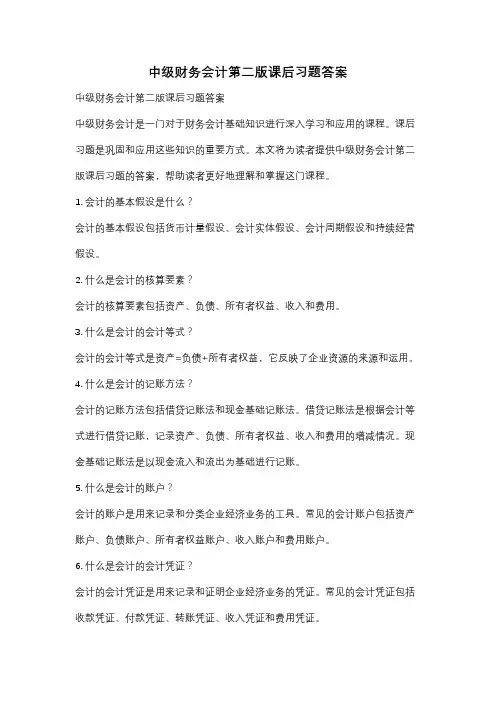
中级财务会计第二版课后习题答案中级财务会计第二版课后习题答案中级财务会计是一门对于财务会计基础知识进行深入学习和应用的课程。
课后习题是巩固和应用这些知识的重要方式。
本文将为读者提供中级财务会计第二版课后习题的答案,帮助读者更好地理解和掌握这门课程。
1. 会计的基本假设是什么?会计的基本假设包括货币计量假设、会计实体假设、会计周期假设和持续经营假设。
2. 什么是会计的核算要素?会计的核算要素包括资产、负债、所有者权益、收入和费用。
3. 什么是会计的会计等式?会计的会计等式是资产=负债+所有者权益,它反映了企业资源的来源和运用。
4. 什么是会计的记账方法?会计的记账方法包括借贷记账法和现金基础记账法。
借贷记账法是根据会计等式进行借贷记账,记录资产、负债、所有者权益、收入和费用的增减情况。
现金基础记账法是以现金流入和流出为基础进行记账。
5. 什么是会计的账户?会计的账户是用来记录和分类企业经济业务的工具。
常见的会计账户包括资产账户、负债账户、所有者权益账户、收入账户和费用账户。
6. 什么是会计的会计凭证?会计的会计凭证是用来记录和证明企业经济业务的凭证。
常见的会计凭证包括收款凭证、付款凭证、转账凭证、收入凭证和费用凭证。
7. 什么是会计的账簿?会计的账簿是用来记录和汇总企业经济业务的工具。
常见的会计账簿包括总账、明细账、日记账、现金账、银行存款账等。
8. 什么是会计的调整分录?会计的调整分录是根据企业实际经济业务的发展情况,在会计期末对账户余额进行调整的分录。
常见的调整分录包括计提折旧、计提坏账准备、计提预提费用等。
9. 什么是会计的财务报表?会计的财务报表是根据会计准则和会计政策编制的反映企业财务状况和经营成果的报表。
常见的财务报表包括资产负债表、利润表、现金流量表和所有者权益变动表。
10. 什么是会计的财务分析?会计的财务分析是通过对财务报表进行分析和解读,评估企业财务状况和经营成果的方法。
常见的财务分析方法包括比率分析、趋势分析和比较分析等。
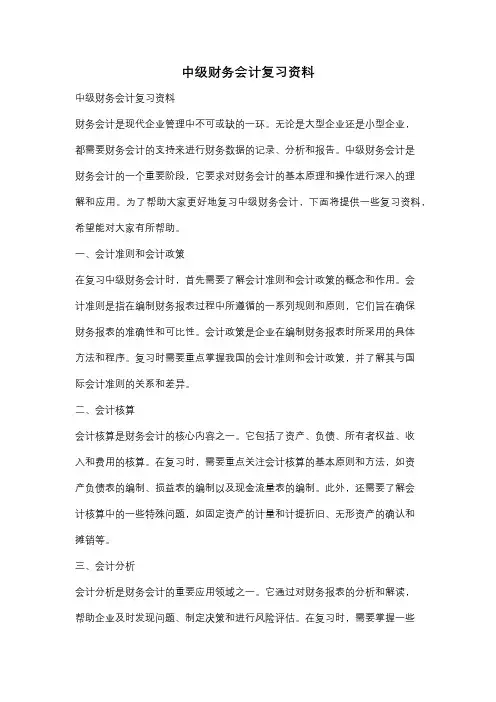
中级财务会计复习资料中级财务会计复习资料财务会计是现代企业管理中不可或缺的一环。
无论是大型企业还是小型企业,都需要财务会计的支持来进行财务数据的记录、分析和报告。
中级财务会计是财务会计的一个重要阶段,它要求对财务会计的基本原理和操作进行深入的理解和应用。
为了帮助大家更好地复习中级财务会计,下面将提供一些复习资料,希望能对大家有所帮助。
一、会计准则和会计政策在复习中级财务会计时,首先需要了解会计准则和会计政策的概念和作用。
会计准则是指在编制财务报表过程中所遵循的一系列规则和原则,它们旨在确保财务报表的准确性和可比性。
会计政策是企业在编制财务报表时所采用的具体方法和程序。
复习时需要重点掌握我国的会计准则和会计政策,并了解其与国际会计准则的关系和差异。
二、会计核算会计核算是财务会计的核心内容之一。
它包括了资产、负债、所有者权益、收入和费用的核算。
在复习时,需要重点关注会计核算的基本原则和方法,如资产负债表的编制、损益表的编制以及现金流量表的编制。
此外,还需要了解会计核算中的一些特殊问题,如固定资产的计量和计提折旧、无形资产的确认和摊销等。
三、会计分析会计分析是财务会计的重要应用领域之一。
它通过对财务报表的分析和解读,帮助企业及时发现问题、制定决策和进行风险评估。
在复习时,需要掌握一些常用的会计分析方法,如财务比率分析、垂直分析和横向分析等。
此外,还需要了解会计分析在企业经营管理中的应用,如经营绩效评价、投资决策和融资决策等。
四、会计报告会计报告是财务会计的最终成果。
它通过财务报表的形式向内外部利益相关方提供企业的财务信息。
在复习时,需要了解财务报表的基本结构和内容,如资产负债表的要素、损益表的要素以及现金流量表的要素。
此外,还需要了解财务报表编制的一些原则和规定,如会计估计和会计政策的披露等。
五、会计信息系统会计信息系统是财务会计的重要支撑。
它通过信息技术的应用,实现财务数据的采集、处理和报告。
在复习时,需要了解会计信息系统的基本结构和功能,如数据采集子系统、数据处理子系统和数据报告子系统等。
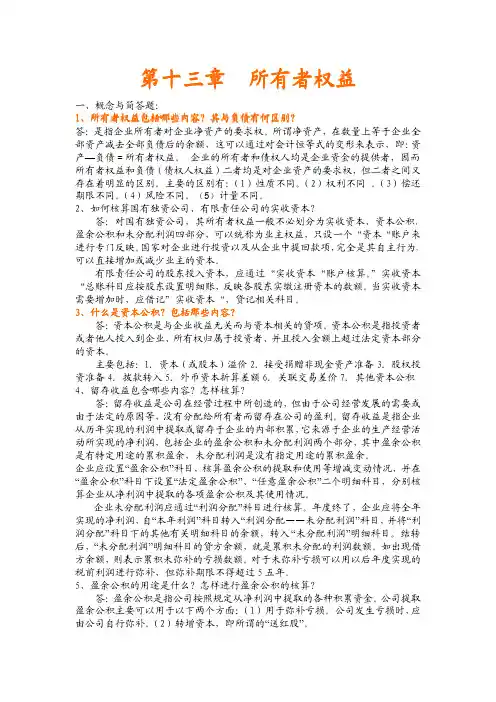
第十三章所有者权益一、概念与简答题:1、所有者权益包括哪些内容?其与负债有何区别?答:是指企业所有者对企业净资产的要求权。
所谓净资产,在数量上等于企业全部资产减去全部负债后的余额,这可以通过对会计恒等式的变形来表示,即:资产—负债=所有者权益。
企业的所有者和债权人均是企业资金的提供者,因而所有者权益和负债(债权人权益)二者均是对企业资产的要求权,但二者之间又存在着明显的区别。
主要的区别有:(1)性质不同。
(2)权利不同。
(3)偿还期限不同。
(4)风险不同。
(5)计量不同。
2、如何核算国有独资公司、有限责任公司的实收资本?答:对国有独资公司,其所有者权益一般不必划分为实收资本、资本公积、盈余公积和未分配利润四部分,可以统称为业主权益,只设一个“资本“账户来进行专门反映。
国家对企业进行投资以及从企业中提回款项,完全是其自主行为,可以直接增加或减少业主的资本。
有限责任公司的股东投入资本,应通过“实收资本“账户核算。
”实收资本“总账科目应按股东设置明细账,反映各股东实缴注册资本的数额。
当实收资本需要增加时,应借记”实收资本“,贷记相关科目。
3、什么是资本公积?包括那些内容?答:资本公积是与企业收益无关而与资本相关的贷项。
资本公积是指投资者或者他人投入到企业、所有权归属于投资者、并且投入金额上超过法定资本部分的资本。
主要包括:1.资本(或股本)溢价2.接受捐赠非现金资产准备3.股权投资准备4.拨款转入5.外币资本折算差额6.关联交易差价7.其他资本公积4、留存收益包含哪些内容?怎样核算?答:留存收益是公司在经营过程中所创造的,但由于公司经营发展的需要或由于法定的原因等,没有分配给所有者而留存在公司的盈利。
留存收益是指企业从历年实现的利润中提取或留存于企业的内部积累,它来源于企业的生产经营活动所实现的净利润,包括企业的盈余公积和未分配利润两个部分,其中盈余公积是有特定用途的累积盈余,未分配利润是没有指定用途的累积盈余。
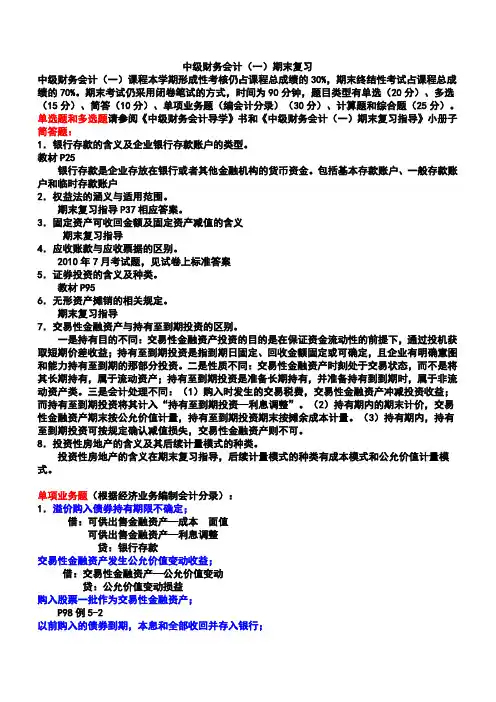
中级财务会计(一)期末复习中级财务会计(一)课程本学期形成性考核仍占课程总成绩的30%,期末终结性考试占课程总成绩的70%。
期末考试仍采用闭卷笔试的方式,时间为90分钟,题目类型有单选(20分)、多选(15分)、简答(10分)、单项业务题(编会计分录)(30分)、计算题和综合题(25分)。
单选题和多选题请参阅《中级财务会计导学》书和《中级财务会计(一)期末复习指导》小册子简答题:1.银行存款的含义及企业银行存款账户的类型。
教材P25银行存款是企业存放在银行或者其他金融机构的货币资金。
包括基本存款账户、一般存款账户和临时存款账户2.权益法的涵义与适用范围。
期末复习指导P37相应答案。
3.固定资产可收回金额及固定资产减值的含义期末复习指导4.应收账款与应收票据的区别。
2010年7月考试题,见试卷上标准答案5.证券投资的含义及种类。
教材P956.无形资产摊销的相关规定。
期末复习指导7.交易性金融资产与持有至到期投资的区别。
一是持有目的不同:交易性金融资产投资的目的是在保证资金流动性的前提下,通过投机获取短期价差收益;持有至到期投资是指到期日固定、回收金额固定或可确定,且企业有明确意图和能力持有至到期的那部分投资。
二是性质不同:交易性金融资产时刻处于交易状态,而不是将其长期持有,属于流动资产;持有至到期投资是准备长期持有,并准备持有到到期时,属于非流动资产类。
三是会计处理不同:(1)购入时发生的交易税费,交易性金融资产冲减投资收益;而持有至到期投资将其计入“持有至到期投资—利息调整”。
(2)持有期内的期末计价,交易性金融资产期末按公允价值计量,持有至到期投资期末按摊余成本计量。
(3)持有期内,持有至到期投资可按规定确认减值损失,交易性金融资产则不可。
8.投资性房地产的含义及其后续计量模式的种类。
投资性房地产的含义在期末复习指导,后续计量模式的种类有成本模式和公允价值计量模式。
单项业务题(根据经济业务编制会计分录):1.溢价购入债券持有期限不确定;借:可供出售金融资产—成本面值可供出售金融资产—利息调整贷:银行存款交易性金融资产发生公允价值变动收益;借:交易性金融资产—公允价值变动贷:公允价值变动损益购入股票一批作为交易性金融资产;P98例5-2以前购入的债券到期,本息和全部收回并存入银行;借:银行存款贷:持有至到期投资—成本—应计利息将可供出售金融资产出售净收入存入银行。
第七章固定资产
一、概念与思考题:
1、什么是固定资产?
答:是指生产商品、提供劳务、出租或经营管理而持有且使用寿命超过一个会计年度的有形资产。
2、简述固定资产的特点:
答:(1 )获取的目的是企业长期使用而不是为了出售,(2)是有形资产,(3)使用寿命长且有限,(4)单位价值较高。
3、固定资产初始确认的条件是什么?答:固定资产同时满足下列条件的才能予以确认:(1)与该固定资产有关的经济利益很可能流入企业,(2)该固定资产的成本能够可靠地计量。
4、什么是固定资产折旧?其折旧方法有几种?各有何特点?答:指一定时期内为弥补固定资产损耗按照规定的固定资产折旧率提取的固定资产折旧,或按国民经济核算统一规定的折旧率虚拟计算的固定资产折旧。
折旧方法有:(1 )年限平均法(直线法),直线法使用方便,易于理解,(2)工作量法(以每单位工作量耗费的固定资产价值相等为前提),该方法实际上是直线法的一个特例,比较符合收入与费用相配比原则,即资产的使用程度越高,则磨损程度也越大,为企业提供的效益越高,计提的折旧费越高。
(3 )加速折旧法:①双倍余额递减法,固定资产净残值不能从其价值中递减,②年数总和法(年限合计法),计算折旧的基数是固定不变的,折旧率依固定资产尚可使用的年限确定,各年折旧率呈递减趋势,依此计算的折旧额也呈递减趋势。
5、什么是固定资产的后续支出?
答:固定资产后续支出是固定资产经初始计量并入账后又发生的与固定资产相关的支出,在核算过程中;首先应根据其具体内容作出资本性支出和收益性支出会计确认;其次应依据支出效用是否有利于固定资产寿命和经营的原则进行相应的核算。
其核算内容包括在原有固定资产基础上进行的改建扩建、改良支出以及修理、装修支出,核算方法应根据具体情况分别列入资本性收入的有关科目和当期费用。
6、什么是固定资产减值?
答:当固定资产存在减值迹象,应当进行减值测试,估计固定资产的可收回金额,可收回金额低于账面价值的,那就是固定资产已发生减值,应当按低于账
面价值的金额计提减值准备。
7、借款费用在何种情况下需进行资本化?如何确定其资本化额?答:借款费用只有同时满足以下三个条件时,才应当开始资本化:(一)资产支出已经发生;(二)借款费用已经发生;
(三)为使资产达到预定可使用或者可销售状态所必要的购建或者生产活动已经开始。
为购建或者生产符合资本化条件的资产而借入一项专门借款的,该专门借款的利率即为资本化率。
企业应当将累计资产支出加权平均数乘以资本化率,计算
确定当期应予以资本化的利息金额。
二、业务题:
1、( 1)购入各种物资
借:工程物资 3 5 3 0 0 0 0
贷:银行存款 3 5 3 0 0 0 0
(2)领用工程物资
借:在建工程-生产车间
2 0 6 0 0 0 0
贷:工程物资
2 0 6 0 0 0 0
(3)应付施工人员工资
借:在建工程-生产车间360000
贷:应付职工薪酬360000
(4)工程物资盘盈
借:工程物资20000
贷:在建工程
20000
(5)购入安装设备
借:在建工程2340000
贷:银行存款 2 3 4 0 0 0 0 借:固定资产 2 3 4 0 0 0 0
贷:在建工程2340000
(6)领用材料
借:在建工程-生产车间 5 0 0 0 0
贷:工程物资 5 0 0 0 0
(7)工程完工交付使用
借:固定资产-生产车间 2 450 000
贷:在建工程-生产车间 2 450 000
(8)借:原材料1 273 504.27
应交税费——应交增值税(进项税额) 216 495.73
贷:工程物资 1 490 000
2、(1)购入设备时
借:在建工程70200
贷:银行存款70200
发生安装费用
借:在建工程
2000
贷:银行存款2000
交付使用
借:固定资产72200
贷:在建工程72200
(2) A机器应分摊的费用比例 1 0 0 0 0 0 / (100000 + 2400
00+300000)=100000/640000=5/32 240000/64000
300000/64000
165468.75 3 9 7 1 2 5
4
9 6 4 0 6.2
1 0 5 9 0 0 0 8 0 0 0 0 0 8000
20000 20000
820 000
820 000
25000 25000
390 000
5 000 5 000 400 000
E 机器应分摊的费用比例
C 机器应分摊的费用比例 借:固定资产—A
-B -C
贷:银行存款
(3) 借:在建工程
贷:银行存款
应予资本化的借款 借:在建工程 贷:应付利息
借:固定资产
贷:在建工程
(4) 借:固定资产
贷:实收资本
(5) 借:固定资产
60000
贷:银行存款
长期股权投资减值准备
银行存款贷:长期股权
投资
(6)借:在建工程
60000
贷:在建工程 6 0 0 0 0
7)以固定资产进行债务重组
借:固定资产清理
累计折旧 固定资产减值准备
贷:固定资产 借:应付账款 贷:
固定资产清理 营业外收入 借:固定资产清理 贷:营业外收入
3、借:待处理财产损益-待处理
固定资产损益
1 2 0 0 0 累计折旧 贷:固定资产
20000 借:营业外支出一固定资产盘亏
1 2 0 0 0 贷:待处理财产损益-待处理固定资产损益 1 2 0 0 0
借:固定资产
8000
贷:以前年度损益调整
8 0 0 0
4> ( 1)直线法: (1 — 5%)/5 = 0.19
1 8 0 0 0 0 5 0 0 0 0
2 0 0 0 0 2 5 0 0 0 0
3 0 0 0 0 2 0 0 0 0 10000 20000
20000
000
每一年折旧额为20000)*0.19 = 38000
(2)双倍余额递减法:
年折旧率=2/5=0.4
第一年200000*0.4 = 80000
第二年(200000 — 80000)*0.4 = 48000
第三年(200000 — 80000 — 48000)*0.4 = 28800
第四年(200000 — 80000 — 48000 — 28800 — 10000) /2=16600 第五年(200000 — 80000 — 48000 — 28800 — 10000) /2=16600 净残值为200000*5%=10000
(3)年数总和法:
第一年200000*(1 — 5%)*5/15 = 63333.33
第二年200000*(1 — 5 %)*4/15 = 50666.67
第三年200000*(1 — 5%)*3/15 = 38000
第四年200000*(1 — 5%)*2/15 = 25333.33
第五年200000*(1 — 5%)*1/15 = 12666.67。